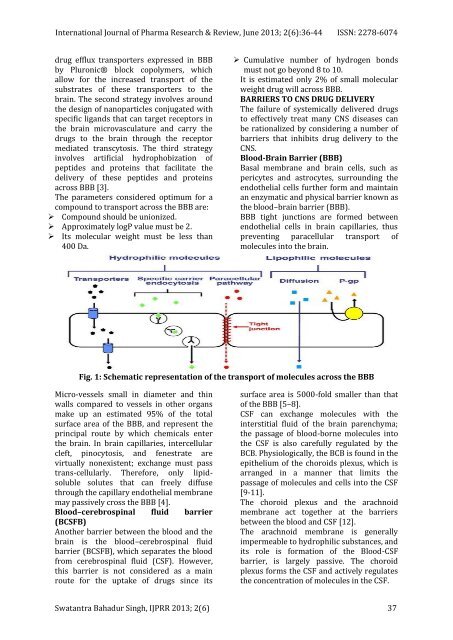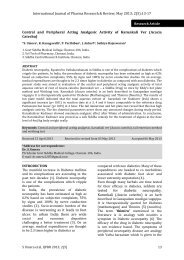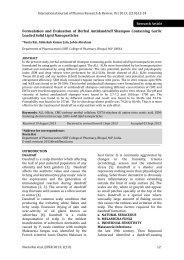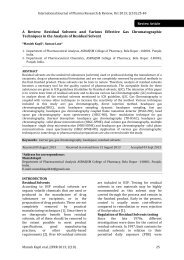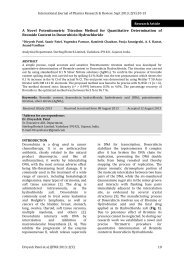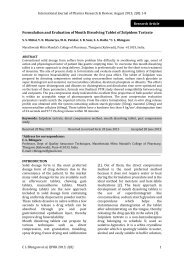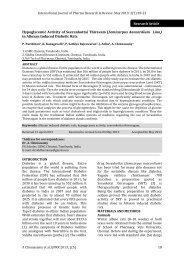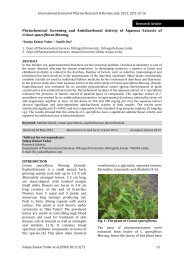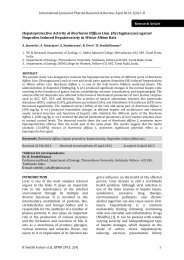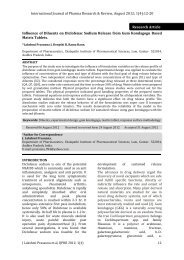Novel Approaches for Brain Drug Delivery System-Review
Novel Approaches for Brain Drug Delivery System-Review
Novel Approaches for Brain Drug Delivery System-Review
- No tags were found...
You also want an ePaper? Increase the reach of your titles
YUMPU automatically turns print PDFs into web optimized ePapers that Google loves.
International Journal of Pharma Research & <strong>Review</strong>, June 2013; 2(6):36-44 ISSN: 2278-6074drug efflux transporters expressed in BBBby Pluronic® block copolymers, whichallow <strong>for</strong> the increased transport of thesubstrates of these transporters to thebrain. The second strategy involves aroundthe design of nanoparticles conjugated withspecific ligands that can target receptors inthe brain microvasculature and carry thedrugs to the brain through the receptormediated transcytosis. The third strategyinvolves artificial hydrophobization ofpeptides and proteins that facilitate thedelivery of these peptides and proteinsacross BBB [3].The parameters considered optimum <strong>for</strong> acompound to transport across the BBB are:‣ Compound should be unionized.‣ Approximately logP value must be 2.‣ Its molecular weight must be less than400 Da.‣ Cumulative number of hydrogen bondsmust not go beyond 8 to 10.It is estimated only 2% of small molecularweight drug will across BBB.BARRIERS TO CNS DRUG DELIVERYThe failure of systemically delivered drugsto effectively treat many CNS diseases canbe rationalized by considering a number ofbarriers that inhibits drug delivery to theCNS.Blood-<strong>Brain</strong> Barrier (BBB)Basal membrane and brain cells, such aspericytes and astrocytes, surrounding theendothelial cells further <strong>for</strong>m and maintainan enzymatic and physical barrier known asthe blood–brain barrier (BBB).BBB tight junctions are <strong>for</strong>med betweenendothelial cells in brain capillaries, thuspreventing paracellular transport ofmolecules into the brain.Fig. 1: Schematic representation of the transport of molecules across the BBBMicro-vessels small in diameter and thinwalls compared to vessels in other organsmake up an estimated 95% of the totalsurface area of the BBB, and represent theprincipal route by which chemicals enterthe brain. In brain capillaries, intercellularcleft, pinocytosis, and fenestrate arevirtually nonexistent; exchange must passtrans-cellularly. There<strong>for</strong>e, only lipidsolublesolutes that can freely diffusethrough the capillary endothelial membranemay passively cross the BBB [4].Blood–cerebrospinal fluid barrier(BCSFB)Another barrier between the blood and thebrain is the blood–cerebrospinal fluidbarrier (BCSFB), which separates the bloodfrom cerebrospinal fluid (CSF). However,this barrier is not considered as a mainroute <strong>for</strong> the uptake of drugs since itssurface area is 5000-fold smaller than thatof the BBB [5–8].CSF can exchange molecules with theinterstitial fluid of the brain parenchyma;the passage of blood-borne molecules intothe CSF is also carefully regulated by theBCB. Physiologically, the BCB is found in theepithelium of the choroids plexus, which isarranged in a manner that limits thepassage of molecules and cells into the CSF[9-11].The choroid plexus and the arachnoidmembrane act together at the barriersbetween the blood and CSF [12].The arachnoid membrane is generallyimpermeable to hydrophilic substances, andits role is <strong>for</strong>mation of the Blood-CSFbarrier, is largely passive. The choroidplexus <strong>for</strong>ms the CSF and actively regulatesthe concentration of molecules in the CSF.Swatantra Bahadur Singh, IJPRR 2013; 2(6) 37


